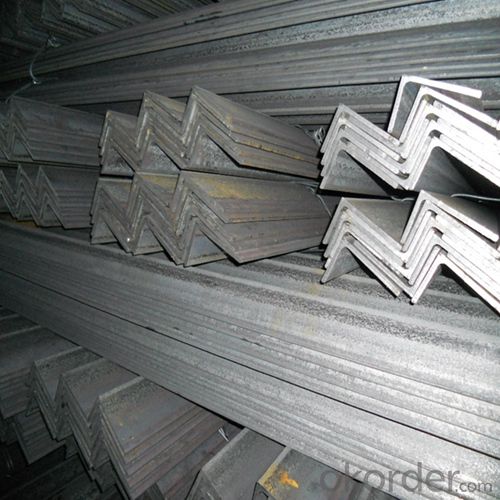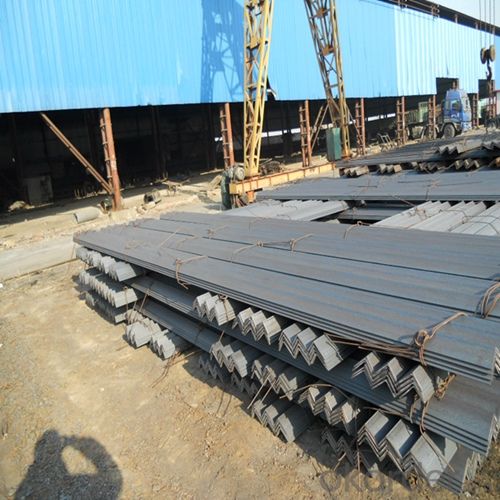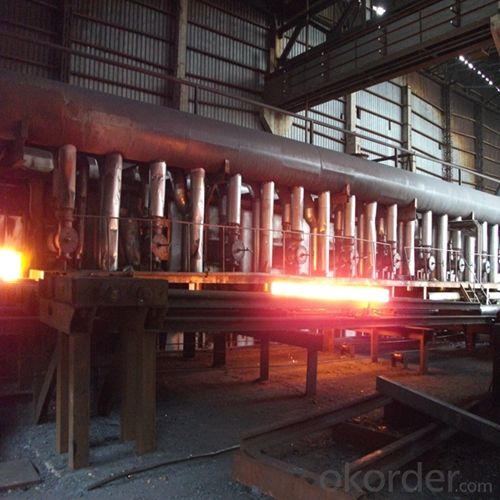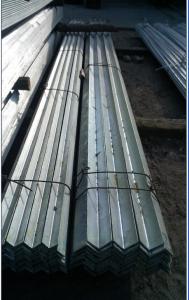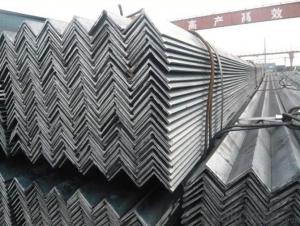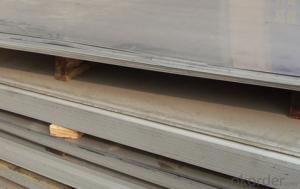Carbon Steel Mild Angle of Middle Sizes Chinese Standard Q235
- Loading Port:
- Tianjin
- Payment Terms:
- TT or LC
- Min Order Qty:
- 25 m.t.
- Supply Capability:
- 30000 m.t./month
OKorder Service Pledge
OKorder Financial Service
You Might Also Like
1. Structure of Carbon Steel Mild Angle of Middle Sizes Chinese Standard Description:
Carbon steel mild angle is a main kind of structure steel and the section is like a letter L. We use carbon steel mild angle for structure construction. Carbon steel mild angle can be erected as soon as the materials are delivered on site. High strength, stiffness, toughness, and ductile properties are advantages of this kind of carbon steel mild angle.
2. Main Features of Carbon Steel Mild Angle of Middle Sizes Chinese Standard:
• Strength - Having high strength, stiffness, toughness, and ductile properties, structural steel is one of the most commonly used materials in commercial and industrial building construction.
• Constructability - Steel equal angle Bar can be developed into nearly any shape, which are either bolted or welded together in construction. Structural steel can be erected as soon as the materials are delivered on site, whereas concrete must be cured at least 1–2 weeks after pouring before construction can continue, making steel a schedule-friendly construction material.
• Fire resistance - Steel is inherently a noncombustible material. However, when heated to temperatures seen in a fire scenario, the strength and stiffness of the material is significantly reduced. The steel equal angle bar can be enveloped in sufficient fire-resistant materials, increasing overall cost of steel structure buildings.
3. Carbon Steel Mild Angle of Middle Sizes Chinese Standard Images:

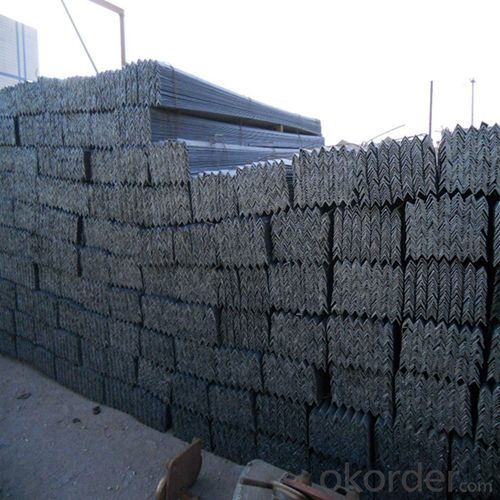
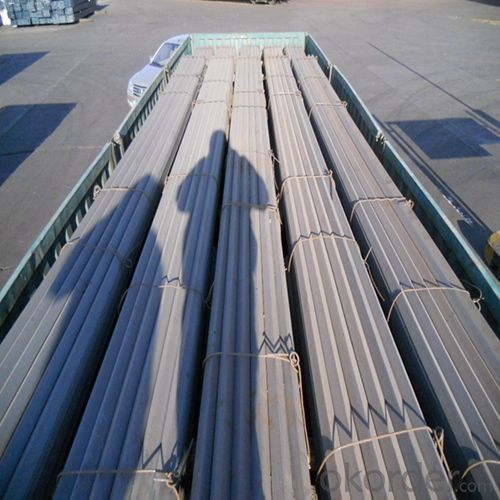
4. Carbon Steel Mild Angle of Middle Sizes Chinese Standard Specification:
Angle | KG/M | Angle | KG/M | Angle | KG/M | Angle | KG/M |
20X20X3 | 0.889 | 60X60X5 | 4.570 | 90X90X8 | 10.946 | 130X130X12 | 23.600 |
20X20X4 | 1.145 | 60X60X6 | 5.427 | 90X90X9 | 12.220 | 130X130X13 | 25.400 |
25X25X2 | 0.763 | 63X63X4 | 3.907 | 90X90X10 | 13.476 | 130X130X14 | 27.200 |
25X25X3 | 1.124 | 63X63X5 | 4.822 | 90X90X15 | 15.940 | 130X130X16 | 30.900 |
25X25X4 | 1.459 | 63X63X6 | 5.721 | 100X100X6 | 9.366 | 140X140X10 | 21.488 |
30X30X2 | 0.922 | 63X63X8 | 7.469 | 100X100X7 | 10.830 | 140X140X12 | 25.522 |
30X30X3 | 1.373 | 63X63X10 | 9.151 | 100X100X8 | 12.276 | 140X140X14 | 29.490 |
30X30X4 | 1.786 | 70X70X4 | 4.372 | 100X100X10 | 15.120 | 140X140X15 | 31.451 |
36X36X3 | 1.656 | 70X70X5 | 5.397 | 100X100X12 | 17.898 | 140X140X16 | 33.393 |
5. FAQ
We have organized several common questions for our clients,may help you sincerely:
①How about the corrosion of the products?
When the steel equal angle bar in contact with water, can corrode, creating a potentially dangerous structure. Measures must be taken in structural steel construction to prevent any lifetime corrosion. The steel can be painted, providing water resistance. Also, the fire resistance material used to envelope steel is commonly water resistant.
②How to inspect the quality?
We have a professional inspection group which belongs to our company. We resolutely put an end to unqualified products flowing into the market. At the same time, we will provide necessary follow-up service assurance.
③What is the difference between steel angle bar and traditional material?
Steel equal angle bar differs from concrete in its attributed compressive strength as well as tensile strength.
- Q: Can steel angles be used in marine applications?
- Yes, steel angles can be used in marine applications. Steel angles are commonly used in the construction of ships, offshore platforms, and other marine structures due to their high strength and durability. They provide structural support and help distribute the weight and stress of the marine environment. Steel angles are resistant to corrosion, especially when coated with protective coatings or galvanized. However, it is important to select the appropriate grade of steel angle that is specifically designed for marine applications to ensure optimal performance and longevity in harsh saltwater environments.
- Q: How do you determine the required angle size for a specific application?
- To determine the required angle size for a specific application, you need to consider factors such as the purpose of the application, the type of material being used, and the desired outcome. It is important to analyze the application's requirements, consult relevant guidelines or standards, and consider any potential safety or functional considerations. Additionally, conducting tests or simulations can help determine the appropriate angle size for optimal performance and efficiency in the given application.
- Q: Can steel angles be used in electrical or telecommunications installations?
- Yes, steel angles can be used in electrical or telecommunications installations. Steel angles are commonly used as structural supports and mounting brackets in these types of installations due to their strength, durability, and versatility.
- Q: What is the typical corrosion rate of steel angles?
- The typical corrosion rate of steel angles can vary depending on various factors such as the environment, exposure to moisture, presence of corrosive substances, and maintenance practices. However, on average, steel angles can experience a corrosion rate of around 0.1 to 1.0 millimeters per year.
- Q: What are the different types of connections for steel angles?
- There are several different types of connections for steel angles, including bolted connections, welded connections, and clip connections. Bolted connections involve using bolts and nuts to secure the angles together, while welded connections are created by melting the edges of the angles together. Clip connections use specially designed clips to hold the angles in place without the need for welding or bolting. Each type of connection has its own advantages and disadvantages, and the choice of connection method depends on factors such as the load-bearing requirements, ease of installation, and cost.
- Q: Can steel angles be used in the construction of hospitals?
- Steel angles are indeed suitable for use in the construction of hospitals. They are commonly employed in construction projects due to their ability to provide structural support and stability. When it comes to constructing hospitals, steel angles have a wide range of applications. They can be used for framing, support beams, trusses, and reinforcing walls and floors. Steel angles are renowned for their strength, durability, and fire resistance, which makes them ideal for meeting the demanding safety requirements of hospital buildings. Moreover, steel angles can be easily fabricated and manipulated to meet the specific design and structural needs of a hospital, allowing for flexibility in the construction process. All in all, steel angles are a dependable and versatile material that can be effectively utilized in hospital construction.
- Q: How do you reinforce a steel angle for added strength?
- To reinforce a steel angle for added strength, there are several techniques you can employ. One common method is to weld additional steel plates or gussets to the angle's flanges. These plates or gussets are typically positioned perpendicular to the angle and are welded along their edges to create a stronger connection. This helps distribute the load and enhance the structural integrity of the angle. Another approach is to bolt or rivet additional steel plates or angles to the existing one, creating a sandwich-like structure. These additional plates or angles can be positioned on either side of the existing angle or even on top, depending on the specific requirements. Bolting or riveting them together ensures a secure connection and reinforces the angle's overall strength. Furthermore, reinforcing a steel angle can also be achieved by employing bracing techniques. This involves adding diagonal steel members, often referred to as braces, to the angle. Braces are typically attached to the angle at multiple points using welding or bolting methods. These braces help redistribute the forces acting on the angle and prevent excessive deflection or bending, thereby increasing its strength. It is important to note that the specific reinforcement method chosen depends on factors such as the load or force the angle will experience, the desired level of strength, and the available resources. Consulting with a structural engineer or a professional in the field is highly recommended to ensure the appropriate reinforcement technique is selected and implemented correctly.
- Q: Can steel angles be used for balcony railings?
- Indeed, balcony railings can be crafted with steel angles. These angles are frequently employed in construction due to their robustness and resilience. They offer essential structural reinforcement and can be conveniently tailored to accommodate the precise measurements and design specifications of a balcony railing. Furthermore, steel angles can be adorned with paint or coatings to harmonize with the desired aesthetic of the balcony. Nevertheless, it is imperative to verify that the steel angles employed adhere to the essential safety regulations and building codes to safeguard the stability and security of the balcony railing.
- Q: How do you prevent corrosion on steel angles?
- There are several preventive measures that can be taken to avoid corrosion on steel angles: 1. Properly cleaning the steel angles is crucial before applying any protective coating. This involves removing dirt, rust, and other contaminants through methods like abrasive blasting, power tool cleaning, or chemical cleaning. 2. Applying a protective coating on steel angles is highly effective in preventing corrosion. Different types of coatings, such as paint, epoxy, zinc-rich coatings, or galvanization, act as barriers between the steel and the environment, keeping moisture and corrosive elements away from the metal. 3. Cathodic protection is another method to protect steel angles from corrosion. It involves connecting sacrificial metals like zinc or aluminum to the steel angles, which corrode instead of the steel when exposed to corrosive elements. Impressed current systems can also be used to provide a protective current to the steel, inhibiting corrosion. 4. Controlling the environment in which steel angles are installed can help prevent corrosion. This includes reducing exposure to moisture, humidity, or corrosive chemicals. Proper ventilation, ensuring proper drainage, and using protective coatings specifically designed for harsh environments can achieve this. 5. Regular inspection and maintenance of steel angles are essential to detect any signs of corrosion early on. Damaged or corroded areas should be promptly repaired to prevent further deterioration. Regular cleaning and reapplication of protective coatings can also help maintain the integrity of the steel angles. By implementing a combination of these preventive measures, the risk of corrosion on steel angles can be significantly reduced, allowing for a longer lifespan and maintained structural integrity.
- Q: What is the process of hot rolling steel angles?
- The production of steel angles through hot rolling comprises a series of procedures that convert raw materials into finished steel angles with specific dimensions and properties. Initially, the raw material, typically a billet or continuous casting, is heated to a temperature above its recrystallization point. This raises the steel's malleability and facilitates shaping. Subsequently, the heated billet enters a rolling mill, where it proceeds through a sequence of rollers. These rollers exert pressure on the billet, causing it to deform and adopt the form of an angle. The angle's shape is determined by the rollers, which possess a groove or profile that corresponds to the desired angle dimensions. During its passage through the rolling mill, the billet undergoes plastic deformation. This involves elongating and reducing its cross-sectional area, resulting in a longer and thinner shape. The deformation process molds the flanges (vertical sides) and web (horizontal section connecting the flanges) of the angle. To maintain the desired shape and dimensions, the steel angle may pass through multiple sets of rollers, each applying pressure and further shaping the angle. This continuous rolling process ensures consistent dimensions and smooth surfaces. Upon completion of the hot rolling process, the steel angles are cooled and straightened. This is typically achieved through water or air cooling methods. Rapid cooling strengthens and hardens the steel, while straightening eliminates any bends or twists in the angles. After cooling and straightening, the steel angles may undergo supplementary procedures such as cutting to the desired length, surface treatments like painting or galvanizing, and quality control inspections to ensure compliance with the required specifications. In summary, the hot rolling process for steel angles involves heating the raw material, passing it through rolling mills for shaping and deformation, cooling and straightening the angles, and ultimately finishing them to meet the desired specifications. This process yields high-quality steel angles that find extensive application in construction, manufacturing, and various other industries.
Send your message to us
Carbon Steel Mild Angle of Middle Sizes Chinese Standard Q235
- Loading Port:
- Tianjin
- Payment Terms:
- TT or LC
- Min Order Qty:
- 25 m.t.
- Supply Capability:
- 30000 m.t./month
OKorder Service Pledge
OKorder Financial Service
Similar products
Hot products
Hot Searches
Related keywords



